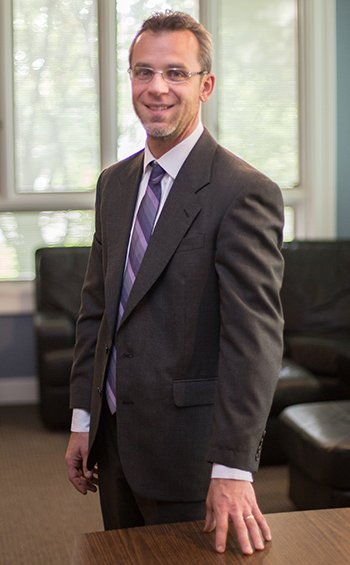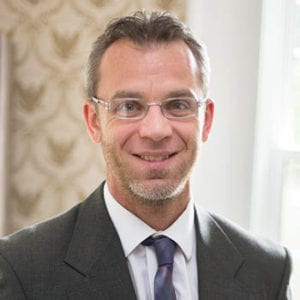Engineering sound financial solutions for clients
Engineering sound financial solutions for clients

Arnie Pechler Jr., CRC • Palmyra, NY
United Professional Advisors, LLC • Ameritas Investment Corp.
Read full biography below
Proactive Advisor Magazine: Arnie, talk about your personal background and how you became a financial advisor.
I grew up in a great family in the northern part of New York, the Finger Lakes region. We later moved near Rome, New York, to a fairly rural part of the state. We were close to the mountains and wilderness areas, and being in the outdoors has always been an important part of my life.
I’ve always been good at mathematics and science, which led me to Rensselaer Polytechnic Institute, where I graduated with a degree in physics. After college, I worked as an engineer for several years in Boston for what was originally Arthur D. Little, and later TIAX. I was involved in technology consulting, data analytics, product design, and research. We worked on a lot of projects for the defense industry.
Eventually, my job started to evolve more toward production management, and I found that a lot less interesting than research and development. My wife and I wanted to return to upstate New York to be closer to family and live in the area where we both enjoyed growing up. My father was always in the financial-services industry, initially as a producer and manager on the insurance side, and later as a comprehensive financial advisor. He worked hard to persuade me to give the financial-services business a chance, so I did on a trial basis.

The trial did not last long. I jumped right in and found I loved helping people with their financial planning, as well as the quantitative side of creating retirement-income plans and building portfolio allocations. I studied for and passed my licensing exams quickly. While that was happening, I was working with my father and other advisors to learn everything I could about the business, having joint meetings with clients, and doing some paraplanning work.
I also took advantage of educational opportunities provided by our broker-dealer and other industry resources. By the time I was fully licensed, I felt very prepared to begin handling clients on my own, consulting with the team as necessary. That was 10 years ago, and I think it was the best career decision I have made. I have since attained the Certified Retirement Counselor (CRC) designation. The course work for the CRC was very beneficial, especially on the behavioral finance aspect of working with clients.
Let’s talk about your practice today. What kinds of clients do you work with, and what process do you use for planning?
We are what the industry would probably define as middle market, with most clients having assets between $250,000 and $2 million. Most of our clients are just regular people who have worked hard all of their lives and tried to save. They come from many backgrounds—a fair amount are small-business owners. Most are about five or 10 years away from retirement or already retired. I have also tried to develop a focus on younger working professionals, clients who will be able to stay with our firm for many years. I am the point person in the firm for clients from engineering or scientific fields since I can speak their language. They can be challenging for many advisors, but once they are comfortable with your professional background and experience, they are great clients.
In terms of my planning process, I find it a little bit amusing how my mindset and approach has evolved. I originally thought I would bring a very scientific and methodical approach to financial planning, starting with the first client meeting. I do get to that point later on in the process, but our initial conversations are highly qualitative, far-ranging, and very much about the client’s big-picture issues, concerns, and aspirations.
As we start building a relationship and get on the same page regarding objectives, I think my quantitative orientation is extremely valuable. I am rigorous in the areas of fact-finding and data-gathering, and I use excellent software to help put together a financial plan and retirement-income options. In a lot of ways, financial planning is a data puzzle with many potential outcomes that requires close analysis. I apply my analytical background, and I think I have a unique approach to solving the complex problems that retirement- and investment-planning present. Our team at UPA has a diverse background, and our collaborative atmosphere helps us all present strong strategies for our clients’ financial needs.
How does collaboration work within your firm? Is that a process-driven approach or more informal?
 It generally works on several different levels. We have a small group of advisors who are in the same physical location, and we tend to speak frequently about our client cases and share the types of strategies we are using for different client retirement- and investment-planning issues. Each of us has various levels and types of experience and certain strengths, so we believe a team-oriented approach works well.
It generally works on several different levels. We have a small group of advisors who are in the same physical location, and we tend to speak frequently about our client cases and share the types of strategies we are using for different client retirement- and investment-planning issues. Each of us has various levels and types of experience and certain strengths, so we believe a team-oriented approach works well.
Going one layer deeper, we have a multi-office firm, and within that culture, we share ideas and resources between advisors in different office locations and discuss a variety of firmwide topics of practical interest. Finally, we have a good support system facilitated by our broker-dealer, Ameritas. I am a member of a peer study group that meets over the phone once a month. These are advisors who are registered with Ameritas Investment Corp. but come from different firms all over the country.
Our regular group has about eight advisors, and the session is led by a moderator from the home office. Once a year we meet in person as a supergroup of about 40 advisors. We talk about goals, challenges, practice management, technology, and sales ideas. We usually have a guest speaker from the home office or an industry group like the National Association of Insurance and Financial Advisors (NAIFA). My personal growth as an advisor and the experience I bring to clients has been tremendously influenced by all of these resources and our firm’s focus on knowledge-sharing.
Describe your approach to developing client portfolio recommendations.
It starts with the overall financial plan and determining the appropriate objectives, time horizons, income requirements, and risk profile. Once those elements are determined with the client, we can move into the area of developing recommended investment allocations and strategies. While I have come to fully appreciate the client-relationship side of the business, portfolio design plays to my strengths on the quantitative side, and I enjoy this type of analysis.
The third-party managers that we work with, and one in particular, are very transparent and provide excellent tools to allow financial advisors to blend different strategies and allocations. I can then look at backtested or actual historical results and perform portfolio optimizations according to various parameters. In many cases, I can look at actual monthly returns over a lengthy time period for fairly unique, actively managed strategies.
“I like the idea of enhancing probabilities based on historical data.”
This is not something you can do in the same way with traditional asset allocation. I have spent a lot of time conducting this sort of analysis and put together my own model that is not overly complex. I believe this model gives clients a higher probability of managing the downside risk or exposure of their portfolio, without making much of a sacrifice on the upside. It essentially was a process of trying to put the risk-reward equation more in our clients’ favor. There are no guarantees, of course, but, as an engineer, I like the idea of enhancing probabilities based on historical data.
A lot of the actively managed strategies we use are very solid on their own. But when you combine several of them for a multi-strategy approach, they are less correlated with the broad market and offer several layers of risk management. I am delighted to be able to present this type of investment management approach to all of my clients, regardless of their net worth.
We are agnostic when it comes to types of asset classes, sectors, geography, or other factors. All that matters to our firm and our clients is pursuing a risk-managed approach to investing that has the potential to deliver the returns that will help them reach their retirement goals. We believe that if you strive to avoid the major losses and capture a good portion of market gains, you are going to progress toward your goals and, importantly, have the confidence to stay with your investment plan.

Peer study groups pay large dividends
Arnie Pechler Jr. credits peer study groups with adding to his body of knowledge and providing a resource for best practices for his firm. Here is how his peer group works together:
- A group of seven or eight advisors from different firms meets monthly over the phone.
- There is a “supergroup” session of about 40 advisors once a year.
- Sessions are moderated by a broker-dealer representative and can include outside speakers.
- Goals, challenges, practice management concepts, new technology, and sales ideas are discussed.
 Arnold (Arnie) Pechler Jr. is a financial advisor with United Professional Advisors, based in Palmyra, New York. Mr. Pechler says his practice creates comprehensive financial plans for individuals and families, with a focus on retirement income. He is a member of the National Association of Insurance and Financial Advisors and has earned the Certified Retirement Counselor (CRC) designation.
Arnold (Arnie) Pechler Jr. is a financial advisor with United Professional Advisors, based in Palmyra, New York. Mr. Pechler says his practice creates comprehensive financial plans for individuals and families, with a focus on retirement income. He is a member of the National Association of Insurance and Financial Advisors and has earned the Certified Retirement Counselor (CRC) designation.
Raised in upstate New York, Mr. Pechler attended Rensselaer Polytechnic Institute, where he graduated with a degree in physics. After college, he performed data analysis, technology research, and product development for well-known companies. After training and working in science and engineering for 10 years, Mr. Pechler says he found his “true calling in the financial-services industry.” In 2007, he joined United Professional Advisors, where his father is also a financial advisor.
Mr. Pechler and his wife have two teen children. The family enjoys spending time outdoors and “enjoying the beautiful area and scenery.” Mr. Pechler says he is an “aspiring 46er,” on his way toward the goal of climbing the 46 highest peaks of New York. A member of the ski team in high school and avid basketball player for many years, he also enjoys camping and canoeing.
Disclosure: Securities and investment advisory services offered through Ameritas Investment Corp. (AIC), member FINRA/SIPC. AIC is not affiliated with Proactive Advisor Magazine (PAM) or United Professional Advisors (UPA). Additional products and services may be available through UPA that are not offered through AIC.
Photography by John Clark

